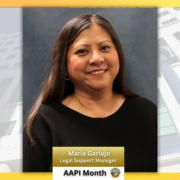Meet the Legislative Unit’s Administrative Analyst Elaine Bissett
In honor of Asian American and Pacific Islander Heritage Month, which is observed throughout the month of May, we are featuring stories of DA employees, what inspired them to pursue a career in public service and their contributions at the DA’s Office.
Meet Elaine Bissett, who is the Administrative Analyst for the DA’s Legislative Unit, and has been with our office for 12 years.
What inspired you to pursue a career in law enforcement/ at the DA’s Office?
“I’ve had an incredible journey with the District Attorney’s Office over the past 12 amazing years! My career started at the San Diego Superior Court, where I updated court dockets and discovered my passion for the prosecution side of the legal system when I started reading case stories. In 2012, when the court faced a budget crisis, I seized the opportunity to join the DA’s Office as a Legal Support Assistant I.
My DA career began in the Economic Crimes Division and later took me to the Administration Division. Over the last 10 years, I’ve worked my way up from a Legal Support Assistant to an Administrative Analyst in the Legislation Unit. In my current role, I coordinate the District Attorney’s sponsored legislation, organize advocacy meetings, track important legislative amendments, and keep in touch with the legislative staff and the Governor’s Office. What I love most about my job is the opportunity to make a real difference in public safety laws and support victims by transforming their experiences into meaningful policies that align with our District Attorney’s vision. As my former director wisely remarked, ‘Your role is crucial for San Diego. We passionately strive to turn ineffective legislation into effective solutions because laws profoundly influence our daily lives.’ It’s incredibly rewarding to know that I am positively impacting our community!
One of the highlights of my career was visiting the Capitol in Sacramento in 2016. Meeting the legislators’ staff and seeing assembly members, senators, and Governor Brown (then) in action was amazing. I even had the opportunity to witness the hearing for a significant bill, SB 813, which was partially inspired by the sexual assault allegations against the scandal-plagued comedian Bill Cosby. This bill eliminated the statute of limitations for rape and sexual assault in the state.”
What does AAPI Month mean to you/why is it important?
“AAPI Heritage Month is significant for me as it underscores the vital contributions of Asian Americans and Pacific Islanders, especially Filipinos, to our nation’s fabric. This month is not just a celebration of our rich cultural identity; it’s a rallying point for advocating diverse representation in government and pursuing inclusive policies that address critical issues like immigration, healthcare access, and the rising tide of anti-Asian hate. It encourages active community engagement and cultural sharing, reminding us of our collective journey toward equality and justice. Ultimately, this month enables us to take action, empowering us to work together for a future where equality and justice flourish for everyone.”
A fun fact about you or what do you enjoy doing in your free time?
“As a proud Filipino who loves celebrating, I enjoy spending my free time with friends. Whether hitting the gym, running briskly, or playing pickleball, our adventures are filled with laughter and joy. My favorite activities are dining out and having delightful days with my family and dogs. Growing up in a beautiful tropical climate has made me appreciate the great outdoors even more, so I knew sunny San Diego would be my ideal home 16 years ago. The Hall of Justice has always been my dream workplace; I remember admiring it while I worked as cruise staff during my walks from the Port of San Diego to shop at Horton Plaza.”










